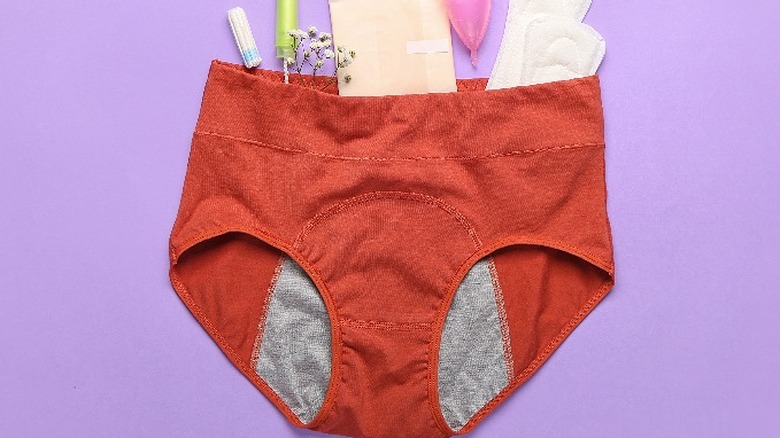Period Underwear Is The Ultimate Convenience, But How Safe Is It?
For those who menstruate, feeling comfortable during a period is essential to getting through what can often be an unpleasant and sometimes downright painful experience. Shedding blood from the uterus is, of course, the main event, but for some folks, menstruation brings about indigestion, mood swings, bloating, and a host of other symptoms.
And let's not forget about the cost, either. The National Organization for Women estimates that buying menstruation products costs people an additional $20 per month, which adds up to thousands over a person's lifetime. Perhaps that wouldn't be so bad if the products were guaranteed to make everyone's lives easier, but pretty much all menstrual products come with their own set of cons. While you can technically sleep with a tampon in, for instance, concerns over the rare event of toxic shock syndrome can put some people off from using them long-term; pads are not particularly eco-conscious; and menstrual cups can cause some people irritation. One product, however, has revolutionized how people experience their menses, and that is period underwear.
Touted as a safe, environmentally-friendly alternative to such products, period underwear are a type of reusable undergarment specially designed to absorb menstrual blood without needing to use additional products. Promising maximum comfort for the wearer, they are marketed as the ultimate convenience. But is period underwear safe to use as suggested?
The inner-workings of period underwear
Designed to look and feel like regular underwear, period underwear is typically made with materials like microfiber polyester that can withhold blood during wear. According to Cleveland Clinic, absorbency can vary depending on the brand, with some period underwear holding up to two tampon's worth of blood. However, one Consumer Reports study found some period underwear capable of absorbing up to 12 regular tampons worth of liquid. The underwear is also usually crafted with several different layers that perform different functions. One component ensures the panties are leak-proof, while another keeps the panties from feeling damp to maximize comfort for the wearer. In any case, most brands advise that period underwear should not be worn for more than 12 hours at a time, and washed after each use.
In the United States, the FDA classifies menstrual products as medical devices, which means brands do not have to disclose what they are made of, despite the fact that they make skin contact with the vagina or vulva. Products such as vaginal wipes, however, are classified as cosmetics, so their ingredients must at least be shared on their labels, per Chemical and Engineering News. Per The New York Times, many companies register period underwear as medical devices, so they're able to bypass the same testing wipes do.
Still, the reusable capabilities of period underwear make them an attractive, cost-effective option for many. Per Grove, some period underwear can last a person from two to five years.
Some period underwear could contain harmful chemicals
One lawsuit has put the safety of period underwear under the microscope. In 2022, period underwear brand Thinx settled a lawsuit for up to $5 million after third-party testing found per-and polyfluoroalkyl substances, or PFAS, in its menstrual underwear. PFAS can be found in cleaning products, cosmetics, varnishes and sealants, and water-proof clothing items. Per Time, the reason they're used in period underwear is to aid with absorbency. The concern here is the most well-studied PFAS (and there are thousands) are classified as possible carcinogen, and PFAS have been researched for several hormonal and reproductive repercussions for women.
Still, it's important to consider that PFAs are not exclusive to period underwear. Per the CDC, "Because of their widespread use and their persistence in the environment, PFAS are found in the blood of people and animals all over the world and are present at low levels in a variety of food products and in the environment." Equally worth noting is that lawsuit was not brought against Thinx because of the alleged harm PFAs caused, but because the product was marketed as being free of harmful chemicals, and allegedly "rigorously tested" for them, despite no evidence proving that testing occurred (via NPR). Still, the lawsuit raised questions about how period underwear brands are able to advertise the claims that they do, and if those claims are actually legitimate. The brand also claimed that certain chemicals used in the production of the panties would not enter the body.
Weighing the benefits and risks
All in all, researches believe more tests need to be completed to determine a stronger link between the human health effects of exposure to PFAS. Prof. Albert Juhasz, who researches the impact of contaminants on human health at the University of South Australia, told The Guardian that when it comes to PFAS, "[The impact of] low-dose chronic exposure is somewhat unclear, as many toxicity studies have investigated toxic effects at elevated concentrations."
However, those with concerns about PFAs should know that they still have options. There are period underwear on the market that have been found not to contain harmful chemicals after testing. Better Goods put together an extensive list of products and the specific antimicrobials used to make them, which can also cause health harm such as hormone disruption, according to the Natural Resources Defense Council.
Moreover, some brands overseas are choosing alternative designs and fabrics to circumvent the need for PFAS in their products. Australian period underwear brand ModiBodi, released a statement declaring to produce their lining with "100% Merino wool for its breathability and natural odor control, polyester/polyamide for absorbency and a thin polyester layer for its lightness and durability" (via The Guardian).



